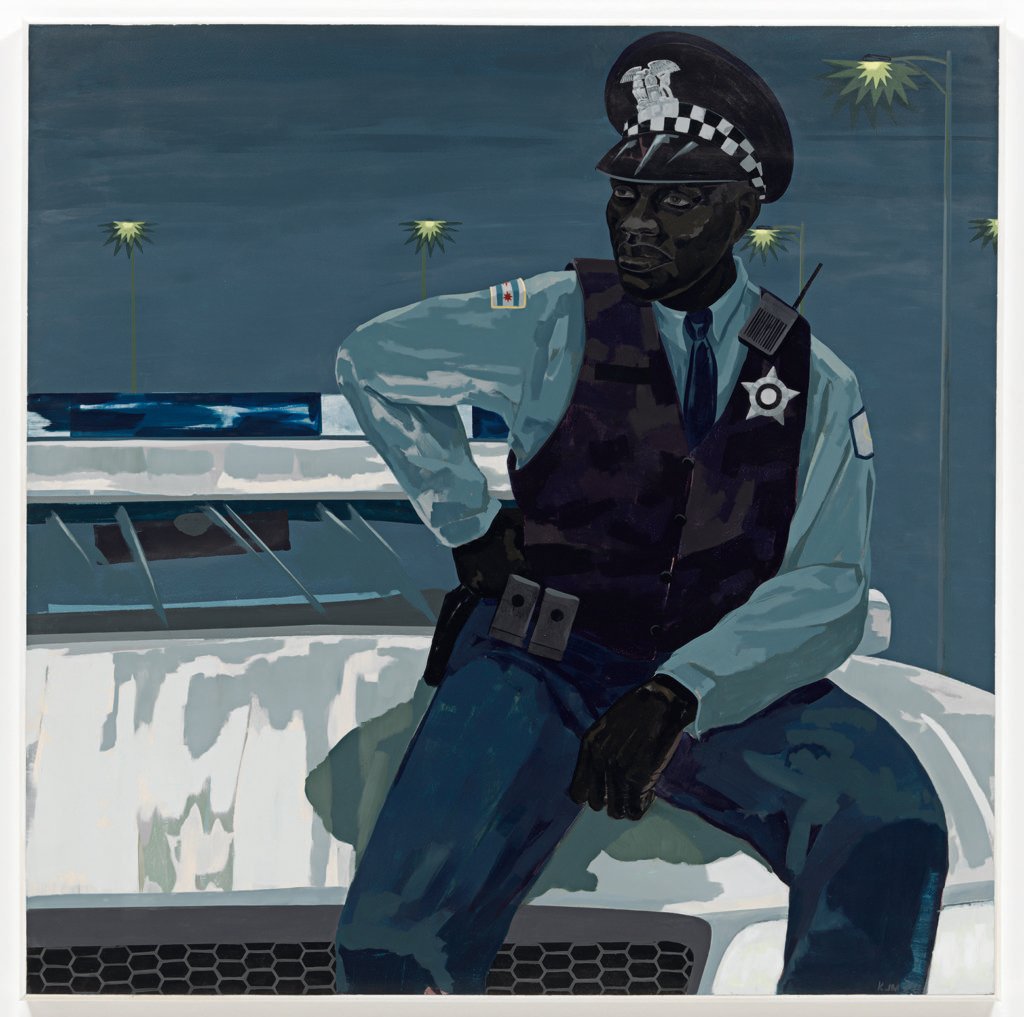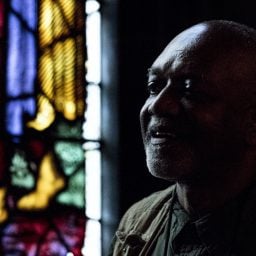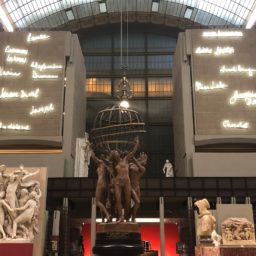“Somebody was here,” wrote Simone Weil, “and the next minute, there is nobody here at all.” This is a spectacle that the police never weary of showing us. Again and again, we see particular officers act on suspicion alone with deadly force. Nearly as often as we see this dehumanizing injustice perpetrated, we see the responsible parties shirk accountability with the full backing of the law. We see entire communities exposed to periodic realizations of this constant threat, as if by a strategy of shock attack. And in most of the recorded cases, we see those who act in this way disappear back into the force, restored astonishingly quickly to the protections offered not merely by their concentrated power but also by the sheer scale and uniformity of their interface with us—one effect of which is to make each officer seem indistinguishable from the next. In our state of heightened countervigilance, we see between the one and the many no really meaningful difference. How do I know that this one isn’t the one? I myself have taken this view of the police since the age of sixteen, and in the meantime I’ve had cause, on more occasions than I care to count, to strengthen my attachment to this way of seeing. In such a situation—let’s call it distributed vigilance—thought is one of the first things to go.
Kerry James Marshall’s 2015 depiction of a black male police officer casts these subjects very differently. The painting’s disposition toward its subject is admirably philosophical, being oriented, conceptually and actually, to the notion of reflection. This is certainly just as true of Marshall’s own disposition. It’s his controversial opinion that a little thought could go a long way, especially among those of us who—amid the latest waves of police violence and of ultraconservative sympathy for its perpetrators—feel specially targeted, and who therefore reflexively ascribe ill intent to the very figure of the police. Marshall has a challenging critique of the command generated early in the Black Lives Matter movement: “Stop Killing Us!” He asks the protester to consider what it means, as he put it to me, “to require somebody else to make the effort and [invest] in your well-being.” Indeed Marshall insists that Untitled was not a response to Ferguson, Cleveland, Baltimore, or any of them. His interest in the relations between black communities and local law enforcement dates to the Watts Riots of 1965, which took place where and when he was growing up, and
none of those particular incidents caused me to become more focused on it. What makes me more interested and attuned to it are the ways that, within black communities where crime operates, we accept a certain kind of status and can only imagine ourselves out of that if somebody allows us to be. I mean, we’re looking for permission to be human. The demand for more black police officers is supposed to remedy a problem that it’s not the police force’s to remedy. It’s ours.
If “we can only imagine ourselves out of that if somebody allows us to be” describes a limitation Marshall ascribes to the rhetoric of Black Lives Matter, it also alludes to a project of self-respect to which Marshall long ago committed his talent for painting. Illogical as it may sound, Marshall chose to paint his way to a solution. That is, for him, Untitled answers a need for the fullest possible address of his relationship, as a maker of paintings, to the more polemical certainties and claims of the political moment. How is another matter entirely. A viewer’s want for something different, or for more, surely has more to do with the demands we place on art at times like this than with anything we can pin on the painter or his picture. Still and all, it’s important to be clear about how the painterly elaboration of a fictional black cop constitutes an action that puts pressure on the claims and approaches cited above.
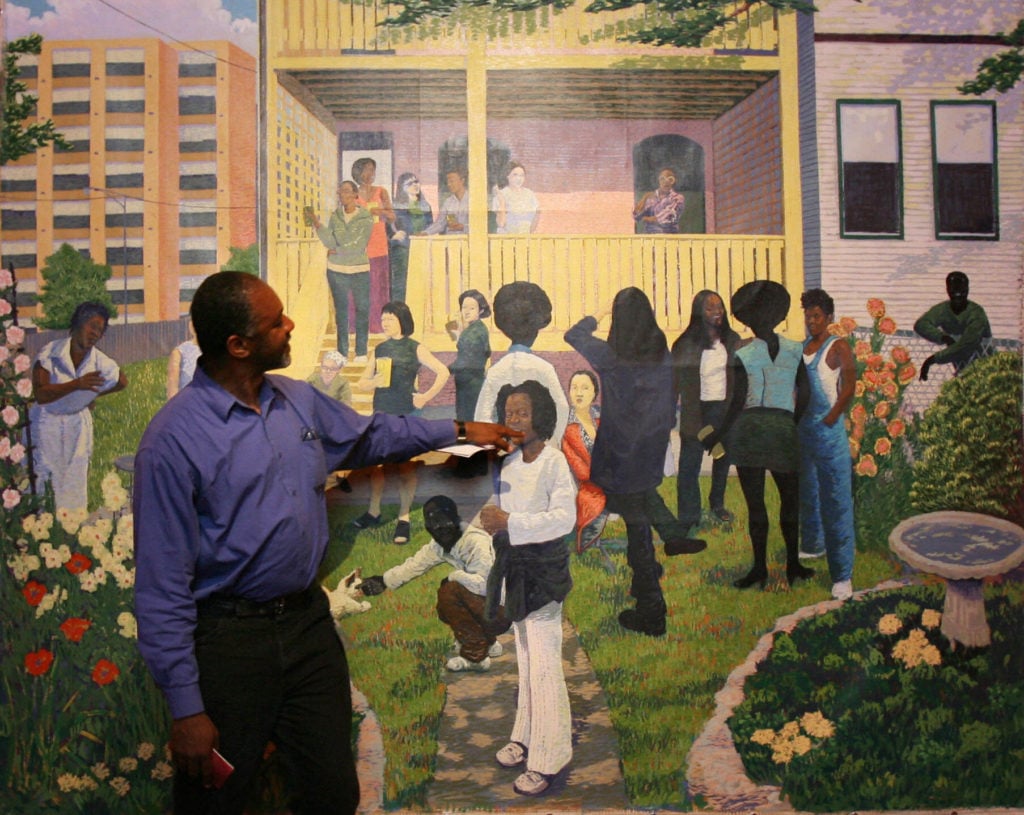
Kerry James Marshall, Garden Party (2003–07), exhibited at documenta 12. Photo: Barbara Sax/AFP/Getty Images.
When working figuratively, Marshall only paints black people—figures wholly distinctive in aesthetic style. More important, they emit with equal constancy that sense of intrinsic worth—the ability to love and to remain indifferent—that some call self-respect. Such people run, as it were, on autonomy. That, of course, is a quality embedded in the historical temporality of modernist painting, a representational convention to whose manner and topoi Marshall holds fiercely—except for its ban on black people. In this critical aspect, Marshall fancies himself a full-time restoration agent. Really black black people function for him, however, as a way not to disclose an (open) secret about modernism, but rather to make of modernism a more completely worldly cultural practice. “Worldly” here describes the attitude of a person, or a thing, that would take its place without wanting the approval of anyone or anything else. But Marshall’s figures show anonymous and fictional qualities that render them irreal by catalyzing their collapse into the pictorial settings they inhabit—settings whose labored yet clearly delineated structures, copious localized embellishments, and near-campy conventionality make it impossible ever to forget you’re looking at a painting.
So, when Marshall addresses a topical theme, as in Untitled, to field that address is to respond to the painting’s invitation into the thought-space allocated to the theme in question. This is, in part, what makes the painting and its suggestions so extraordinarily hard to take. But these difficulties are manifest, describable, and, I think, worth worrying. Untitled invites divergence from more ways of thinking/knowing about contemporary race terror than Black Lives Matter countenances. The policing practices that fuel violence are thoroughly visual; the strategies and tactics of those pursuing conventional confrontations with race terror are too. Both depend on a distance—a fantasy of absolute, maintainable distance—that both shootings and tactical counterattacks dramatically collapse. If the cycle can be narrated as acting at close range on what one knows from a distance, then one pivotal problem that Untitled (policeman) throws up is the problem of the pause, or what Weil called the “tiny interval that is reflection.” How to proceed from the pause that Untitled solicits, given the uncomfortable uncertainty of both?
The painting as such looks without judgment at a subject whom we may find it hard not to judge. It’s not enough, though, to suggest that the picture looks neutrally at this stereotypical figure of masculine strength and security; on its own, such a putative neutrality might seem an ill guest in today’s climate. In making the work, Marshall took matters further by devising a compositional scheme that locates the viewer’s eye level at roughly four feet in relation to the officer. Upon noting this scale, a mature viewer’s first thoughts might turn to a Tamir Rice or an Aiyana Stanley-Jones, who, at the respective ages of 12 and 7, may have stood at around that height when their lives were ended. Marshall’s scale game acknowledges a differently empathetic possibility: by giving us an image of the police officer as he appears in a child’s-eye view, it may take us back to a point in our personal experience when reflexive distrust of such people was unthinkable—when we might have looked up to them, as it were, in precisely the way that Untitled asks us to do again, only now of all times.
At 60 by 60 inches, Untitled draws the viewer into extremely close company with its subject. This cocoon of nearness can grow uncomfortable fast, but a few, minimally consoling distractions lie within. Marshall’s lavish treatment of all 360 square inches of the surface with flattened acrylic yields an image that sets up densely while lying low against the PVC support. When Marshall makes a picture like this, he planes the surface as he goes, canceling the kind of paint buildup that would impede the eye’s free travel across and around the whole image. Traversing it accordingly, one observes a great deal of felicity in his handling of his white-hot subject; clearly there was much pleasure in the work’s making. It helps to view the picture diagrammatically, as it comprises but three distinct zones of intense, concentrated interaction among just a few colors: blues and yellows for the sky, grays and whites for the police cruiser, blacks and blues for the figure. This simplicity of plan, or more precisely its integrated stillness, ratchets up the impact of the more constantly vibratory elements of the image. Paradigmatic in this regard, for me, is the life in the shadows and the white car’s surface, its chromatic uniformity shattered by Marshall’s figuration of reflected light. It’s from a perception of these that one realizes how much more there is to the situation than surface-oriented looking can assimilate on its own, even if utterly in tune with all the incident that enlivens the car and the figure. Despite the relative straightforwardness of the painting’s visual appeal, then, deep and sustained attention will be needed to see what makes it work.
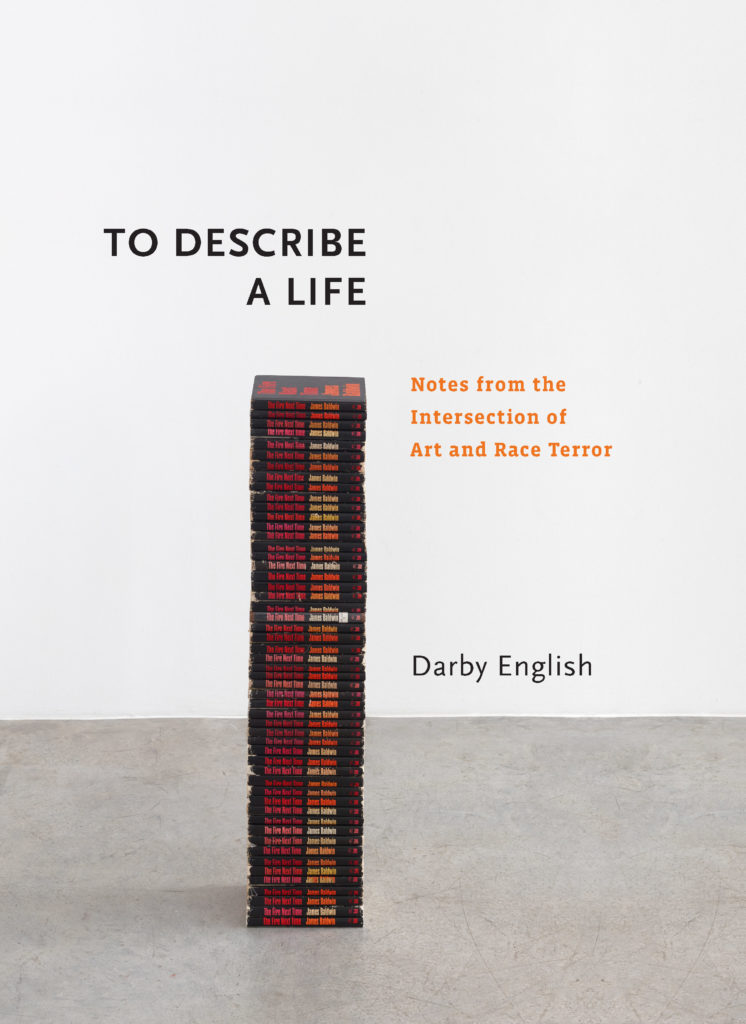
The cover of Darby English’s new book To Describe a Life: Essays at the Intersection of Art and Race Terror (Yale University Press).
Marshall labors hard with the intricacies of his subject: a black male police officer in his professional setting, presumably his precinct, again presumably the black community that has long served as the default setting for Marshall’s figurative painting. Marshall is quick to insist that Untitled is not a portrait (despite the traditional format and pose), that its setting is not the present (despite the image’s topicality), and that the scene isn’t necessarily Chicago, despite a few suggestions that it must be (the distinctive checkerboard band and the shield on the officer’s cap, the profile of his badge, and the flag patch on his right arm are hallmarks of the Chicago Police Department). With these disavowals Marshall doesn’t renounce the picture’s realism so much as tip it into another register. He modeled the officer’s head, for instance, on a Headliner, a brand of rubberized-plastic figurine loosely depicting a sports star or other such as an oversized head stuck atop a much smaller, in fact risibly disproportionate body. Marshall adores the keen mimesis of the Headliners’ heads, saying, “I use them for form, if I need to know how light hits a cheek if someone’s grinning or smiling.” Or staring impassively, as in the present case. Marshall turned from life and photographic models toward these toys some years ago, in pursuit of what he unironically calls “realness.” In this usage, realness does not so much deceive as diverge, having taken a turn that opens its theme (nature, ostensibly) up to reconstructive play. The painting’s core seriousness has its origin in this interrelation between the spirit of the toy and the exercise of technically proficient painting. Here is Marshall again:
You just have more choices, more information in those little heads than [in] all those photographs you take. [It’s] realness because of the three-dimensional spaces. From any side, any angle, you can get a sense of how the shapes play across the head at that angle. I use those heads where there are details that . . . make for a more convincing image. Because I’m shaping the presence of that figure. It doesn’t have to just be satisfying but also convincing.
Indeed, Marshall also painted the police car from a toy model, a replica of a Police Interceptor, a car—a customization of the Ford Crown Victoria luxury sedan—once used by the city of Chicago but decommissioned over a decade ago. Here again, Marshall worked from the toy not due to any scarcity of full-scale Police Interceptors but because he likes the way its lurid color and plasticky polish ensnare, tint, and throw the available light.
So it turns out that the most worked intricacies of Marshall’s subject are other than we might have expected: he’s most intent about the ones that heighten the image’s unreality and stress its quality of madeness or invention. The weirdo realness of his rhetoric underpins Untitled thoroughly. In the picture, a painterly real related to specific mechanisms of artistic representation, at once rational and technical in the extreme and deeply identified with modes of play, intersects with the social-historical real. The result is an authentic and radical instability. Indeed the image lacks a great deal more to dwell on. Not unrelated to a withholding, the realness in play is that of a performance: Untitled (policeman) comprises no sociological referent but gives itself entirely over to a rendition of social facts. What appears at first as so much constructional or painterly incident, the sort of stuff we might deem marginal to the painting’s project, is in fact what it most assiduously thematizes. One could put this another way, and say that a pivotal term of Untitled’s realness is an emergent and persevering tension between what we want to see and what is actually on display (i.e., what he presents for our consideration). He’s painting his way through it.
The painting is a welter of frustrations, through which, rather than despite which, it reaches its eloquent if unverbal comment on the roiling conflict in which civilians and cops now find themselves. Assimilating the image of the police officer to a painting, Marshall figures that theme in his own terms. The prevailing logic of movement is Marshall’s—toward the police, in all their realness. The indefiniteness of space and form in Untitled is itself productive of a specific disorientation: one is rudely displaced from the distanced, objectivizing vantage point on such figures that is so de rigueur just now. While the pose and place are thick with moment, the terms of their narration are entirely unrestricted. Marshall tells us not how to think. Rather, he asks us to hold the ideas “black” and “policeman” at the same time, and, further, to hold this possibly excruciating pose.
I first came to realize this while trying to reckon with the painting’s weirder-than-weird space. Marshall fitted considerable depth into the picture by the use of one-point perspective, only then to conceal the space thus elaborated. Such a treatment brings the representation into line with real space, though not by means of illusion. Because Marshall leaves it unindicated in the finished work, this space must be felt, or remembered. In the scene, the modeling of masses, stacking of parts, and overlapping of laboriously defined objects suggest a space far more extensive than what we actually see. A succession of frictions plays out across the relationships between the car hood, the windshield, and the pursuit light; the figure, the car, and the sky; the head and the lamppost immediately to his left, which intersects with his radio aerial, almost touching his head; and the legs and the car hood. Other compositional decisions ratchet up this tightness rather than relieve it. The cruiser behind and beneath the cop presses hard against his lower legs. The slanted windshield and sloping hood only quicken this sense, which can be corroborated at the lower right, where an area of deep navy acrylic pools at the figure’s left knee, suggesting back-weighted contact between body and surface. It’s quite as though the figure we encounter were pressed up against the picture plane, sandwiched if not a bit squashed between it and the front edge of the parked car. In any event, a more extended activity in depth—an activity through bodily movement—is denied him. The logic of movement in space that governs him is like but also unlike that of the spaces we inhabit, where real citizens and policemen mix and whose protocols many of us know by heart and observe with apprehension. Untitled represents an incident drawn from the real world, but again, its realness is of another kind. Marshall does not give us an imaginary as extended as our own, as so much of his art does. Drawn as close to the viewer as a painting will permit it to go, his subject sits for our close and considered appraisal.
Reprinted from To Describe a Life: Notes from the Intersection of Art and Race Terror by Darby English, published by Yale University Press in association with the Hutchins Center for African & African American Research © 2019. Reprinted by permission. The publication is available at Yale Books.
